-
 Thin iron tsuba of round form with design of family crests (mon) and arabesque (karakusa) in brass or copper inlay (suemon-zōgan) and occasional scattered brass dots or nail heads in ten-zōgan. Seppa-dai outlined with brass wire in the shape of a rope; kozuka-hitsu-ana outlined with scalloped brass wire. Rounded rim with iron bones (tekkotsu). The surface covered with lacquer (urushi). Ōnin school. Late Muromachi period, 16th century. Family crests on the face: 1:30: Two lines (double stripe) encircled (maruni futatsu biki). 4:30: Stylized clove (choji). 7:30: Divided rhombus, or four lozenges incorporated in one (wari-bishi); it is also called Takeda-bishi, the family crest of warrior Takeda Shingen (among the others). 10:00: Stylized Genji-mon (Genji kō-zu) or incense symbol. On the reverse: 2:00 - "Chinese cloud" not a crest. 5:00: Bit (Kutsuwa) 7:30: Number four in a fan (ōgi-san) 10:30: Two dots in a well frame (igeta).
Thin iron tsuba of round form with design of family crests (mon) and arabesque (karakusa) in brass or copper inlay (suemon-zōgan) and occasional scattered brass dots or nail heads in ten-zōgan. Seppa-dai outlined with brass wire in the shape of a rope; kozuka-hitsu-ana outlined with scalloped brass wire. Rounded rim with iron bones (tekkotsu). The surface covered with lacquer (urushi). Ōnin school. Late Muromachi period, 16th century. Family crests on the face: 1:30: Two lines (double stripe) encircled (maruni futatsu biki). 4:30: Stylized clove (choji). 7:30: Divided rhombus, or four lozenges incorporated in one (wari-bishi); it is also called Takeda-bishi, the family crest of warrior Takeda Shingen (among the others). 10:00: Stylized Genji-mon (Genji kō-zu) or incense symbol. On the reverse: 2:00 - "Chinese cloud" not a crest. 5:00: Bit (Kutsuwa) 7:30: Number four in a fan (ōgi-san) 10:30: Two dots in a well frame (igeta). -
 The right sheet of (optional) triptych: Geisha (Geiko) and kabuki actor Iwai Hanshirō V as Katanaya Hanshichi from Three pleasures of present-day Osaka (Tōsei Naniwa no sankō)「当世浪花の三興 芸子」 「刀屋半七」五代目岩井半四郎. Publisher: Iseya Rihei [伊勢屋利兵衛] (Japanese, fl. 1790s – c. 1879) Year: 1821 (Bunsei 4). Size: Vertical ōban; 36.5 x 25.2 cm. Signed: 於浮瀬亭国貞画 – Drawn by Kunisada in Ukabuse (Ukabuse ni oite Kunisada ga). Ukabuse is the name of a famous restaurant in Osaka, this signature can be found only on a three print bijin series [Kunisada Project]. Censor's seal: kiwame 改印:極 Actor Iwai Hanshirō V [岩井半四郎] (Japanese, 1776 – 1847); other names: Iwai Tojaku, Iwai Kumesaburō I. Character: Katanaya Hanshichi [刀屋半七] Ref: MFA ACCESSION NUMBER 11.21938; LIB-2967.2022 Izzard. Full series (triptych) Three Pleasures of Present-day Osaka (Tōsei Naniwa no sankō):
The right sheet of (optional) triptych: Geisha (Geiko) and kabuki actor Iwai Hanshirō V as Katanaya Hanshichi from Three pleasures of present-day Osaka (Tōsei Naniwa no sankō)「当世浪花の三興 芸子」 「刀屋半七」五代目岩井半四郎. Publisher: Iseya Rihei [伊勢屋利兵衛] (Japanese, fl. 1790s – c. 1879) Year: 1821 (Bunsei 4). Size: Vertical ōban; 36.5 x 25.2 cm. Signed: 於浮瀬亭国貞画 – Drawn by Kunisada in Ukabuse (Ukabuse ni oite Kunisada ga). Ukabuse is the name of a famous restaurant in Osaka, this signature can be found only on a three print bijin series [Kunisada Project]. Censor's seal: kiwame 改印:極 Actor Iwai Hanshirō V [岩井半四郎] (Japanese, 1776 – 1847); other names: Iwai Tojaku, Iwai Kumesaburō I. Character: Katanaya Hanshichi [刀屋半七] Ref: MFA ACCESSION NUMBER 11.21938; LIB-2967.2022 Izzard. Full series (triptych) Three Pleasures of Present-day Osaka (Tōsei Naniwa no sankō):


-
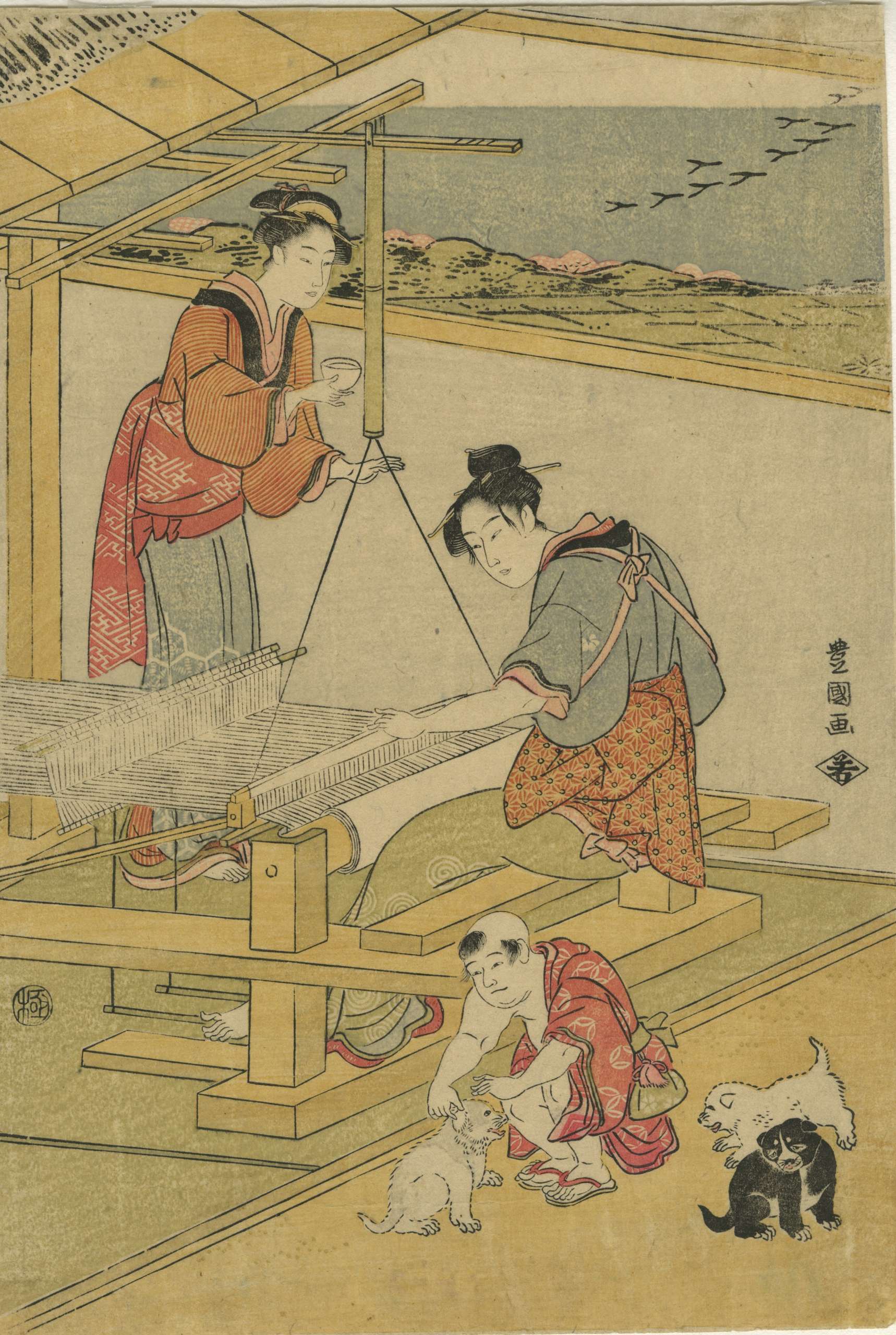 Utagawa Toyokuni I. Women Weaving and Boy Playing with Puppies. c. 1790's. Publisher Wakasaya Yoichi (Jakurindô). Vertical aiban; 32.2 x 21.5 cm (12 11/16 x 8 7/16 in.). MFA ACCESSION NUMBER 06.671. Signed Toyokuni ga 豊国画. Censor's seal: kiwame 改印:極 SOLD
Utagawa Toyokuni I. Women Weaving and Boy Playing with Puppies. c. 1790's. Publisher Wakasaya Yoichi (Jakurindô). Vertical aiban; 32.2 x 21.5 cm (12 11/16 x 8 7/16 in.). MFA ACCESSION NUMBER 06.671. Signed Toyokuni ga 豊国画. Censor's seal: kiwame 改印:極 SOLD -
 Attributed to Suzuki Harunobu (Japanese: 鈴木 春信; c. 1725 – 7 July 1770). Sunga. Woman dreaming of making love. British museum attributes to Ippitsusai Buncho (一筆斉文調).
Attributed to Suzuki Harunobu (Japanese: 鈴木 春信; c. 1725 – 7 July 1770). Sunga. Woman dreaming of making love. British museum attributes to Ippitsusai Buncho (一筆斉文調). -
 Iron tsuba of round form profusely decorated with brass inlay of plants, birds, well, and family crests (mon) in suemon-zōgan technique and occasional brass dots (nail-heads) or ten-zōgan. Seppa-dai and kozuka-hitsu-ana outlined with brass inaly, possibly repaired: rope-shaped wire here and there replaced with flat wire. The plate is very thin, with remnants of lacquer. Ōnin school. Size: 75.8 x 75.2 x 2.3 mm. Weight: 77.5 g. On the front side (omote) motif includes the following elements (from 12 o'clock, clockwise):
Iron tsuba of round form profusely decorated with brass inlay of plants, birds, well, and family crests (mon) in suemon-zōgan technique and occasional brass dots (nail-heads) or ten-zōgan. Seppa-dai and kozuka-hitsu-ana outlined with brass inaly, possibly repaired: rope-shaped wire here and there replaced with flat wire. The plate is very thin, with remnants of lacquer. Ōnin school. Size: 75.8 x 75.2 x 2.3 mm. Weight: 77.5 g. On the front side (omote) motif includes the following elements (from 12 o'clock, clockwise):- Water plantain (a.k.a. arrowhead, or omodaka): "a perpetual plant of the water plantain family, was also called shōgunsō (victorious army grass). Because of this martial connotation, it was a design favored for the crests of samurai families" [see: Family Crests of Japan. // Stone Bridge Press, Berkeley, CA, 2007; p. 63].
- Heron (sagi): "...considered an emblem of longevity, and from China comes the practice of regarding the bird as a mount of the gods and the Taoist sennin. [...] heron also reflects an inauspicious connotation, for the word sagi is homophone for 'fraud' and 'false pretenses'." [see: Merrily Baird. Symbols of Japan. Thematic motifs in art and design. // Rizzoli international publications, Inc., 2001; p. 112]. Some may say, that this is not a heron but a crane (tsuru). It's very possible, and in this case the negative connotation is lost, but the reference to longevity and allusion to sennin remain.
- Pampas grass (susuki, or obana): as per Merrily Baird, p. 95 and John W. Dower, p. 66, pampas grass is one of the Seven Grasses of Autumn. When combined with flying wild gees, conveys strong autumnal mood.
- Plum blossom (ume): according to Merrily Baird, the flower has a vast variety of symbolic meanings, including longevity, and a reference to the Chinese Taoists. It is used in 80 family crests [see: Japanese Design Motifs: 4,260 Illustrations of Japanese Crests; Compiled by the Matsuya Piece-Goods Store; Translated by Fumie Adachi. // Dover Publications, Inc., 1972.] Plum is "celebrated for its sweet perfume, delicate blossoms, and habit of blooming at the end of winter".
- Tree flying wild geese (kari): "Wild geese arrive in large flocks in southern regions during the autumn months, and following their migratory instincts, head back north in spring" [Family Crests of Japan, pp. 85-86]. "The importance of geese in Japanese art was further secured by stories of several military heroes who had achieved victory in battle when a sudden breaking of ranks by flying geese signaled an ambush. The protective role of the birds led to their frequent use in decorating sword furnishings and possibly also their adoption as a family crest motif.Finally, the goose in Asia plays a role in religious traditions" [Merrily Baird, pp.111-112].
- Hikiryō (line, or bar, or stripe) - a symbol which consists of one, two, or three horizontal or vertical stripes in a circle. "In wartime, Japanese generals [...] surrounded their encampments with huge cloth curtains. Usually these were made of cloth sewn together horizontally and varying in color [...] to distinguish the individual general and his followers. The stripe thus assumed strong martial connotations, and became a mark of identification on personal military gear as well. In the early fourteenth century the heads of the Ashikaga and Nitta, then the two most powerful clans in Japan, both adopted stripe patterns as a family crest". [See: Family Crests of Japan, p. 111 and John W. Dower. The elements of Japanese design - A handbook of family crests, heraldry & symbolism. // Weatherhill, New York, Tokyo, 1985, p. 144].
- Hikiryō, see above.
- Pampas grass (susuki, or obana), see above.
- Bellflower (kikyo): One of the Seven Grasses of Autumn. "As a crest, it have been adopted among the warriors around the thirteenth century, primarily because of it's beauty" [John W. Dower, p. 48].
- Four flying wild geese (kari), see above.
- Weeping willow (yanagi): "It is commonly represented with water, snow, swallows, or herons. A branch of willow (yoshi) is one of the attributes of the Buddhist deity Senju Kannon (Thousand-Armed Kannon), who is said to use the branch to sprinkle the nectar of life contained in a vase. [Merrily Baird, pp. 66-67].
- Lone plum blossom in a well frame/crib (igeta, izitsu): "Well crib was one of the most popular motifs in Japanese heraldry". As a crest it may stay simply for the first character (i) of the family name, however, with a flower inside the well frame, and together with the other symbols present, it may aggravate the sense of autumn-ness. The ten-zōgan dots in this particular case may represent the snowflakes or autumn stars.
-
 Iron tsuba of quatrefoil form with design of bamboo stems and leaves, and a plank bridge in openwork (sukashi). Hitsu-ana of irregular form. Iron with smooth chocolate patina. Copper and shakudō sekigane. This piece is illustrated in Sasano: Japanese Sword Guard Masterpieces from the Sasano Collection, 1994 on page 295 under № 254 with the following description:
Iron tsuba of quatrefoil form with design of bamboo stems and leaves, and a plank bridge in openwork (sukashi). Hitsu-ana of irregular form. Iron with smooth chocolate patina. Copper and shakudō sekigane. This piece is illustrated in Sasano: Japanese Sword Guard Masterpieces from the Sasano Collection, 1994 on page 295 under № 254 with the following description:Nishigaki. First generation Kanshiro (died in the sixth year of Genroku, 1693, at the age of 81). Sukashi design: Bamboo (take). Early Edo period, late 17th century (Kanbun / Enppo era). Height: 72.6 mm; Width: 71.5 mm; Rim thickness: .6 mm; Centre thickness: 5.1 mm. Rounded rim. The shape of this sword guard is a quatrefoil and the design is arranged in the form of a saddle flap. Two bamboo trunks with leaves comprise the design. Calm, soothing and sophisticated are the features of this artist in his later years. Such characteristics may remind one of the work of the first Hikozo.
Provenance: Sasano Masayuki collection, № 254. What is interesting, and what had been found by Bruce Kirkpatrick, is that in the earlier photograph of the same piece ['Sukashi tsuba - bushido no bi' by Sasano Masayuki, photography by Fujimoto Shihara, 1972 (in Japanese), page 245, №201] we clearly see kebori - linear carving that decorates the bamboo leaves and the planks of the bridge. The said kebori have totally disappeared between 1972 and 1994. The tsuba became absolutely flat! Now we can only speculate about the reasons for such cruel treatment of the artistically and historically important item.
Sukashi tsuba - bushido no bi. Author: Sasano Masayuki, photography: Fujimoto Shihara, 1972 (in Japanese). Page 245, №201.
-
 A yamagane (unrefined copper) ko-kinko tsuba of slightly elongated round form with design of wisteria carved in sculptural relief (nikubori). Copper sekigane. Unsigned. Muromachi period, likely the 16th century.
A yamagane (unrefined copper) ko-kinko tsuba of slightly elongated round form with design of wisteria carved in sculptural relief (nikubori). Copper sekigane. Unsigned. Muromachi period, likely the 16th century.Size: 74.3 x 71.8 x 3.2 mm.
NBTHK certificate №4003986: Hozon (worthy preservation). In custom wooden box. -
 Iron tsuba of oval form with design of a gourd or aubergine vine with fruits, leaves, and blossoms climbing a trellis, and a fence in yellow brass and red copper flat inlay (hira-zōgan); inlay engraved. Two latticed windows represented by openwork (sukashi). The iron web has deep black patina. The seller attributes this tsuba to Heianjo-Namban school, whatever it means. Momoyama or early Edo period, 17th century. Kaga or Heianjō School. Unsigned. Height: 77.3, Width: 73.1, Thickness at seppa-dai: 3.6 mm.
Iron tsuba of oval form with design of a gourd or aubergine vine with fruits, leaves, and blossoms climbing a trellis, and a fence in yellow brass and red copper flat inlay (hira-zōgan); inlay engraved. Two latticed windows represented by openwork (sukashi). The iron web has deep black patina. The seller attributes this tsuba to Heianjo-Namban school, whatever it means. Momoyama or early Edo period, 17th century. Kaga or Heianjō School. Unsigned. Height: 77.3, Width: 73.1, Thickness at seppa-dai: 3.6 mm. -
 Iron tsuba of round form with design of two paper lanterns in openwork (small cut-outs, ko-sukashi ) outlined with brass wire. The plate is decorated with four concentric rows of brass dot inlay (ten-zōgan), with a brass circular wire inside the innermost row of dots (missing on the back). Hitsu-ana of rectangular form is not outlined with brass wire, which let us suppose that it was cut out at a later date. Copper sekigane. Mid Muromachi period (1454-1513). Diameter: 74.0 mm, thickness: 2.6 mm. Tsuba is illustrated at: 新版 日本刀講座 小道具鑑定編 本間 薫山 佐藤 寒山 : Shinhan Nihonto Koza, Volume VI, Kodogu Part 1. Under supervision of Honma Kunzan and Sato Kanzan. 鍔 無名 応仁 鉄地) 丸形 小透 槌目 真鍮据文 点象嵌 丸耳 : Tsuba with no signature, Ōnin style. Base metal iron (jigane), round shape, small perforations (ko-sukashi), hammering finish (tsuchime). Pre-cast brass inlay (shinchu suemon-zōgan); dot inlay (ten-zōgan); round edge (maru-mimi).
Iron tsuba of round form with design of two paper lanterns in openwork (small cut-outs, ko-sukashi ) outlined with brass wire. The plate is decorated with four concentric rows of brass dot inlay (ten-zōgan), with a brass circular wire inside the innermost row of dots (missing on the back). Hitsu-ana of rectangular form is not outlined with brass wire, which let us suppose that it was cut out at a later date. Copper sekigane. Mid Muromachi period (1454-1513). Diameter: 74.0 mm, thickness: 2.6 mm. Tsuba is illustrated at: 新版 日本刀講座 小道具鑑定編 本間 薫山 佐藤 寒山 : Shinhan Nihonto Koza, Volume VI, Kodogu Part 1. Under supervision of Honma Kunzan and Sato Kanzan. 鍔 無名 応仁 鉄地) 丸形 小透 槌目 真鍮据文 点象嵌 丸耳 : Tsuba with no signature, Ōnin style. Base metal iron (jigane), round shape, small perforations (ko-sukashi), hammering finish (tsuchime). Pre-cast brass inlay (shinchu suemon-zōgan); dot inlay (ten-zōgan); round edge (maru-mimi).
 English translation of the book indicated above Nihon Tō Kōza, Volume VI, Part 1 by Harry Afu Watson, AFU Research Enterprises, Inc., 1993. Tsuba in question illustrated on page 14 and described as follows: " Tsuba mumei Ōnin. Tetsu ji maru gata ko-sukashi tsuchime shitate shinchū suemon ten zogan maru mimi. Brass suemon". My question remains: why such a text is called 'translation' while it looks more like transliteration of romanization?
English translation of the book indicated above Nihon Tō Kōza, Volume VI, Part 1 by Harry Afu Watson, AFU Research Enterprises, Inc., 1993. Tsuba in question illustrated on page 14 and described as follows: " Tsuba mumei Ōnin. Tetsu ji maru gata ko-sukashi tsuchime shitate shinchū suemon ten zogan maru mimi. Brass suemon". My question remains: why such a text is called 'translation' while it looks more like transliteration of romanization? -
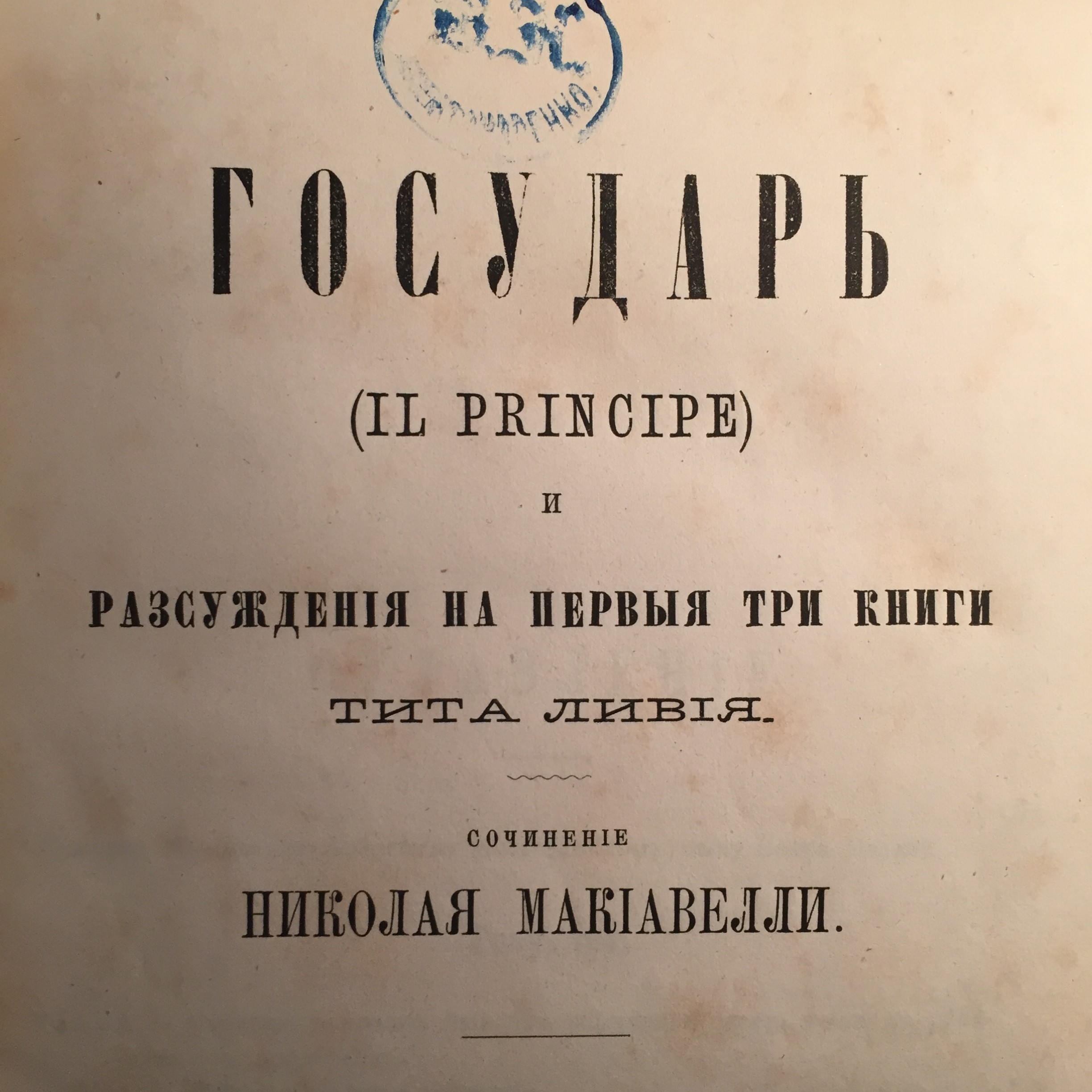
Макиавелли Николай. Государь (Il Principe) и Рассуждения на первые три книги Тита Ливия. Пер. c итал. Н. Курочкина. Издание "Русской книжной торговли". - СПб.; тип. Тиблена и Ко. (Неклюдова), 1869. - 502 стр.
-
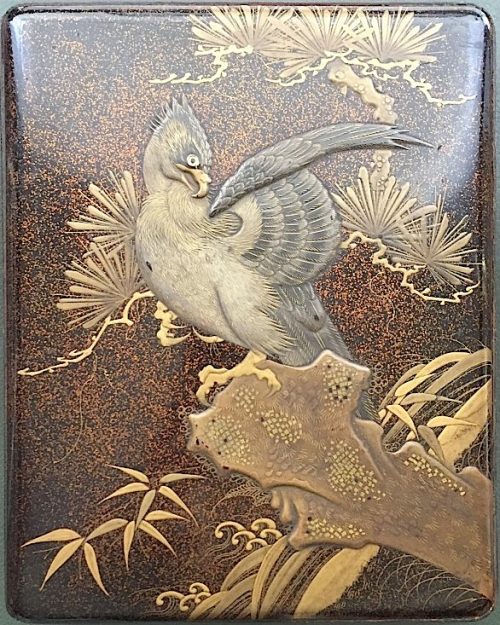 Japanese lacquer writing box (suzuribako) with an eagle sitting on a pine tree over the see waves. Rectangular box with rounded corners, slightly convex overlapping lid. Lacquer on wood with maki-e decoration in gold powder. The lid decorated inside with pine cones and needles over gold maki-e. Edo or Meiji period, 19th century.
Japanese lacquer writing box (suzuribako) with an eagle sitting on a pine tree over the see waves. Rectangular box with rounded corners, slightly convex overlapping lid. Lacquer on wood with maki-e decoration in gold powder. The lid decorated inside with pine cones and needles over gold maki-e. Edo or Meiji period, 19th century. -

Каторга и ссылка. Историко-революционный вестник. Книга 9, № 2, 1924. Общество бывших политических каторжан и ссылно-поселенцев. Под общей редакцией Вл. Виленского (Сибирякова). Москва, 1924. Государственное издательство "Типография Печатный Двор", Ленинград. Тираж: 4,000 экз. Две гравюры на дереве А.И.Кравченко "В дни скорби. Похороны В.И. Ленина на Красной площади" и "В.И.Ленин в Доме Союзов. 23-27 января 1924 г."
-
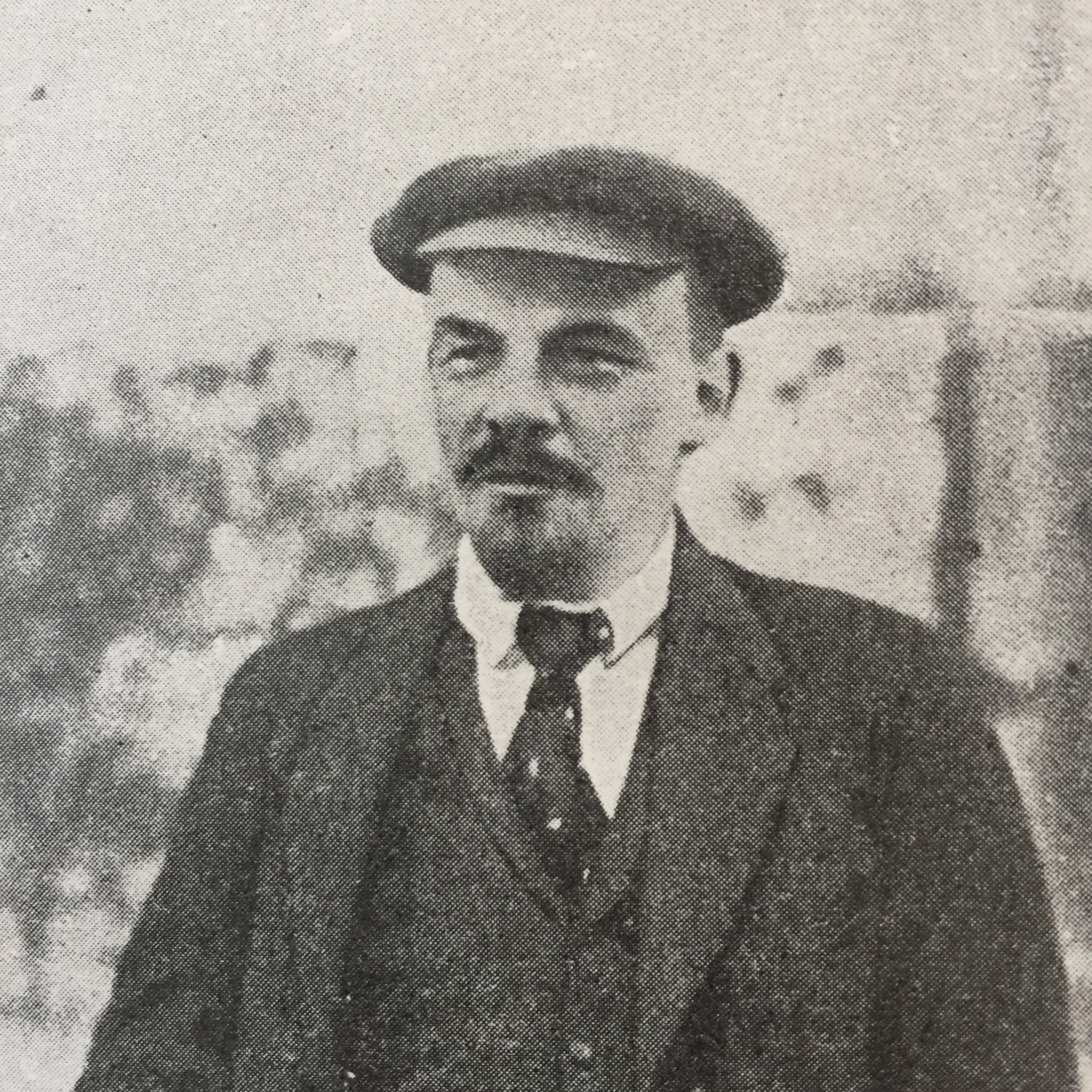
Каторга и ссылка. Историко-революционный вестник. Книга 8, № 1, 1924. Общество бывших политических каторжан и ссылно-поселенцев. Под общей редакцией Вл. Виленского (Сибирякова). Москва, 1924. Государственное издательство "Типография Печатный Двор", Ленинград. Тираж: 4,000 экз.
-
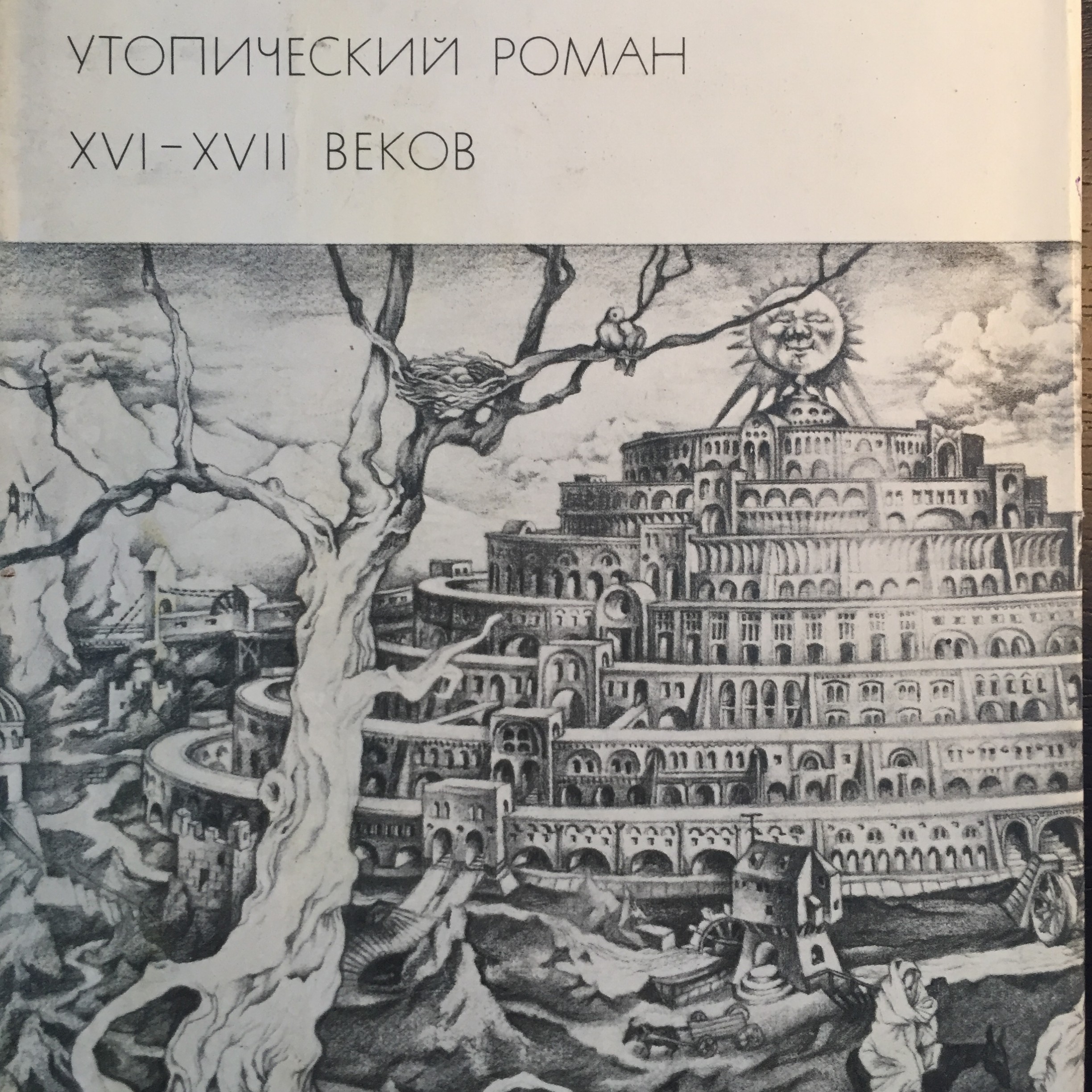 Title page: УТОПИЧЕСКИЙ РОМАН XVI – XVII ВЕКОВ | ТОМАС МОР | УТОПИЯ |•| КАМПАНЕЛЛА | ГОРОД СОЛНЦА |•| ФРЭНСИС БЭКОН | НОВАЯ АТЛАНТИДА |•| СИРАНО ДЕ БЕРЖЕРАК | ГОСУДАРСТВА ЛУНЫ |•| ДЕНИ ВЕРАС | ИСТОРИЯ СЕВАРАМБОВ | {PUBLISHER’S DEVICE} | ИЗДАТЕЛЬСТВО | «ХУДОЖЕСТВЕННАЯ ЛИТЕРАТУРА» | МОСКВА • 1971 || Pagination: [1-4] 5-493 [494] [2], 10 plates extraneous to collation. Collation: 16mo; [1]16 2-1516 168. Binding: 20.5 x 15 cm, burgundy cloth, gilt serial device to cover, gilt lettering to spine, pictorial DJ. Colophon: БИБЛИОТЕКА ВСЕМИРНОЙ ЛИТЕРАТУРЫ | СЕРИЯ ПЕРВАЯ | Том 34 || Print run 300,000 copies
Title page: УТОПИЧЕСКИЙ РОМАН XVI – XVII ВЕКОВ | ТОМАС МОР | УТОПИЯ |•| КАМПАНЕЛЛА | ГОРОД СОЛНЦА |•| ФРЭНСИС БЭКОН | НОВАЯ АТЛАНТИДА |•| СИРАНО ДЕ БЕРЖЕРАК | ГОСУДАРСТВА ЛУНЫ |•| ДЕНИ ВЕРАС | ИСТОРИЯ СЕВАРАМБОВ | {PUBLISHER’S DEVICE} | ИЗДАТЕЛЬСТВО | «ХУДОЖЕСТВЕННАЯ ЛИТЕРАТУРА» | МОСКВА • 1971 || Pagination: [1-4] 5-493 [494] [2], 10 plates extraneous to collation. Collation: 16mo; [1]16 2-1516 168. Binding: 20.5 x 15 cm, burgundy cloth, gilt serial device to cover, gilt lettering to spine, pictorial DJ. Colophon: БИБЛИОТЕКА ВСЕМИРНОЙ ЛИТЕРАТУРЫ | СЕРИЯ ПЕРВАЯ | Том 34 || Print run 300,000 copiesВступительная статья: Л. Воробьев
Томас Мор: Утопия. Перевод А. Малеина и Ф. Петровского.
Томмазо Кампанелла: Город Солнца. Перевод Ф. Петровского.
Фрэнсис Бэкон: Новая Атлантида. Перевод З. Александровой.
Сирано де Бержерак: Государства Луны. Перевод Е. Гунста.
Дени Верас: История Севарамбов. Перевод Е. Дмитриевой.
Примечания А. Малеина, Ф. Петровского, Ф. Коган-Бернштейн, Ф. Шуваевой.
Художник: Селиверстов, Юрий Иванович (Russian, b. 1940) Authors, translators:More, Sir Thomas (British, 1478 –1535)
Campanella, Tommaso (Italian, 1568 – 1639) Bacon, Francis (British, 1561 –1626) Cyrano de Bergerac, Savinien de (French, 1619 – 1655) Vairasse d' Allais, Denis (French, c. 1630 – 1672) Малеин, Александр Иустинович (Russian, 1869 – 1938) Петровский, Фёдор Александрович (Russian, 1890 – 1978) Елизавета Ивановна Дмитриева [Васильева; Черубина де Габриак] (Russian, 1887 – 1928) Александрова, Зинаида Николаевна (Russian, 1907—1983) Гунст, Евгений Анатольевич (Russian, 1901 – 1983) Коган-Бернштейн, Фаина Абрамовна [Аронгауз] (Russian, 1899 – 1976) -
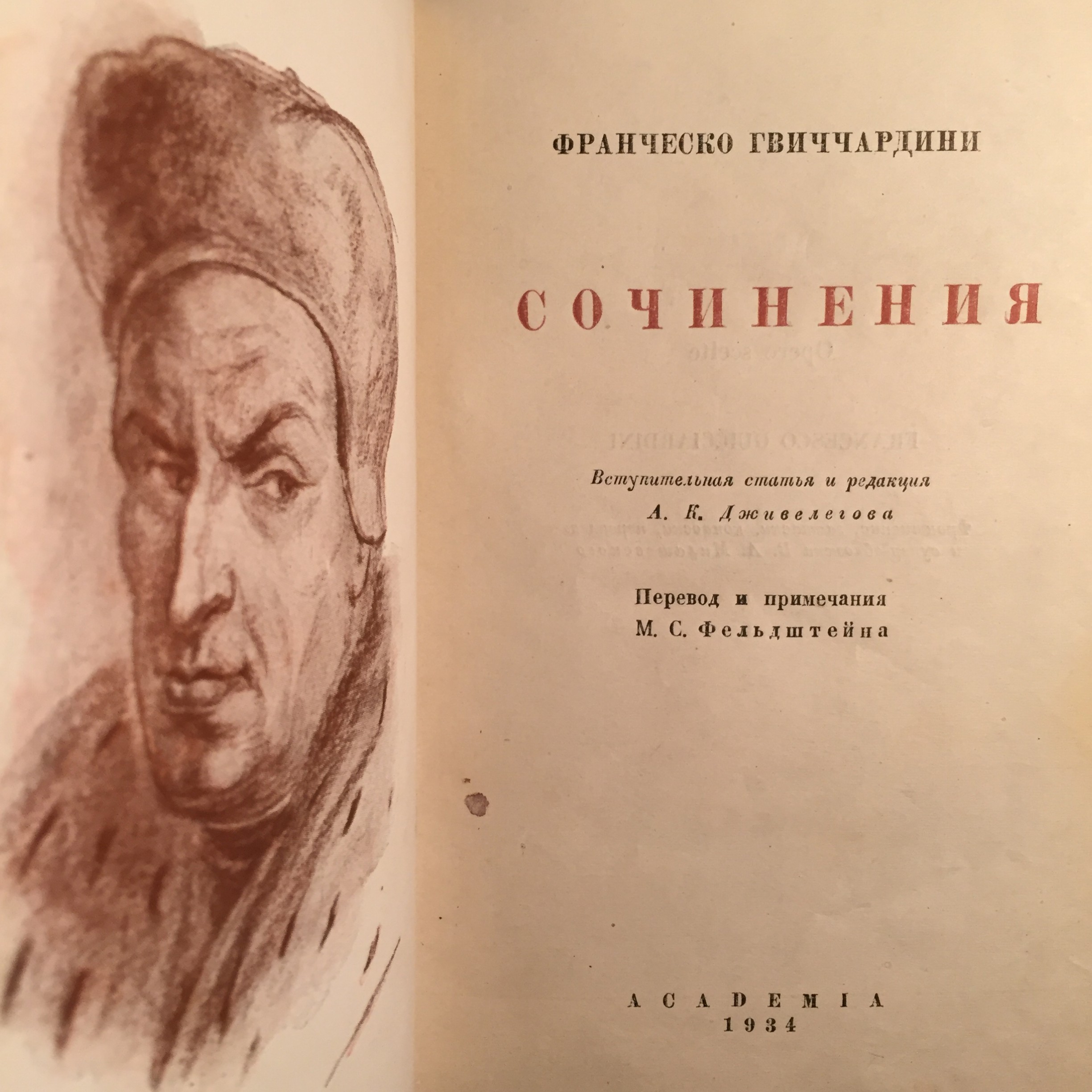
Гвиччардини Франческо. Сочинения. Вступительная статья и редакция Алексея Карповича Дживелегова. Пер.М.Фельдштейна. -- М.: Academia, 1934. -- 552 стр. Тираж: 5300 экз.
Заметки о делах политических и гражданских. Семейная хроника. Воспомнинания о себе самом.
Серия: "Итальянская литература" под общей редакцией А. К. Дживелегова.
-
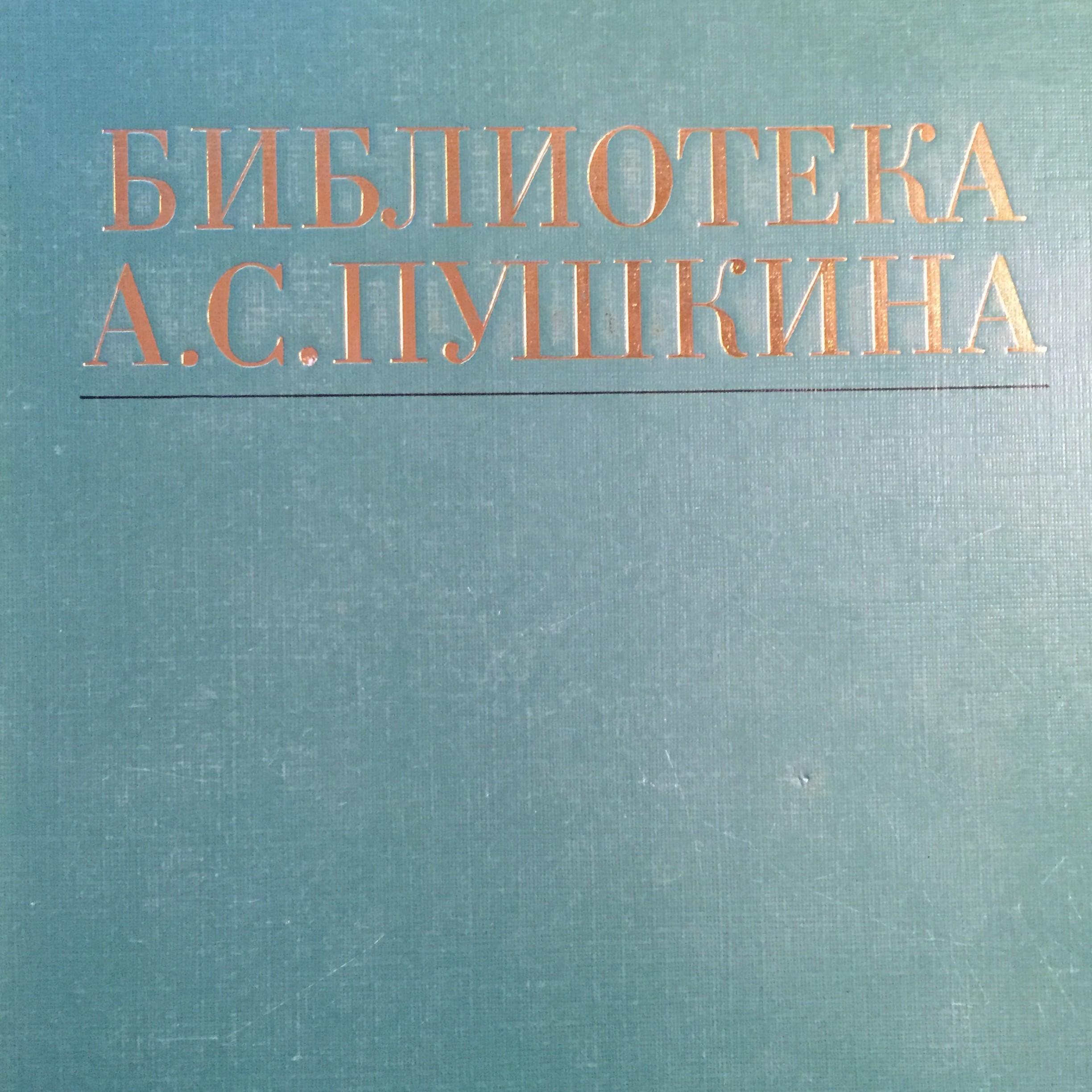
Б. Л. Модзалевский. Библиотека А.С.Пушкина. Библиографическое описание. Отдѣльный оттискъ из изданiя "Пушкинъ и его современники", вып. IX-X. -- СПб.: Тип. Императорской Академiи Наук, 1910. - 442 стр. [РЕПРИНТ 1988 года.]
Библиотека А. С. Пушкина. Б. Л. Модзалевский. Приложение к репринтному изданию. -- М.: Книга, 1988. - 115 стр. Тираж 10 000 экз.
Л. Б. Модзалевский. Библиотека Пушкина. Новые материалы.
Список условных сокращений.
Л. С. Сидяков. Библиотека Пушкина и ее описание.
Примечание к работам Б. Л. и Л. Б. Модзалевских.
-
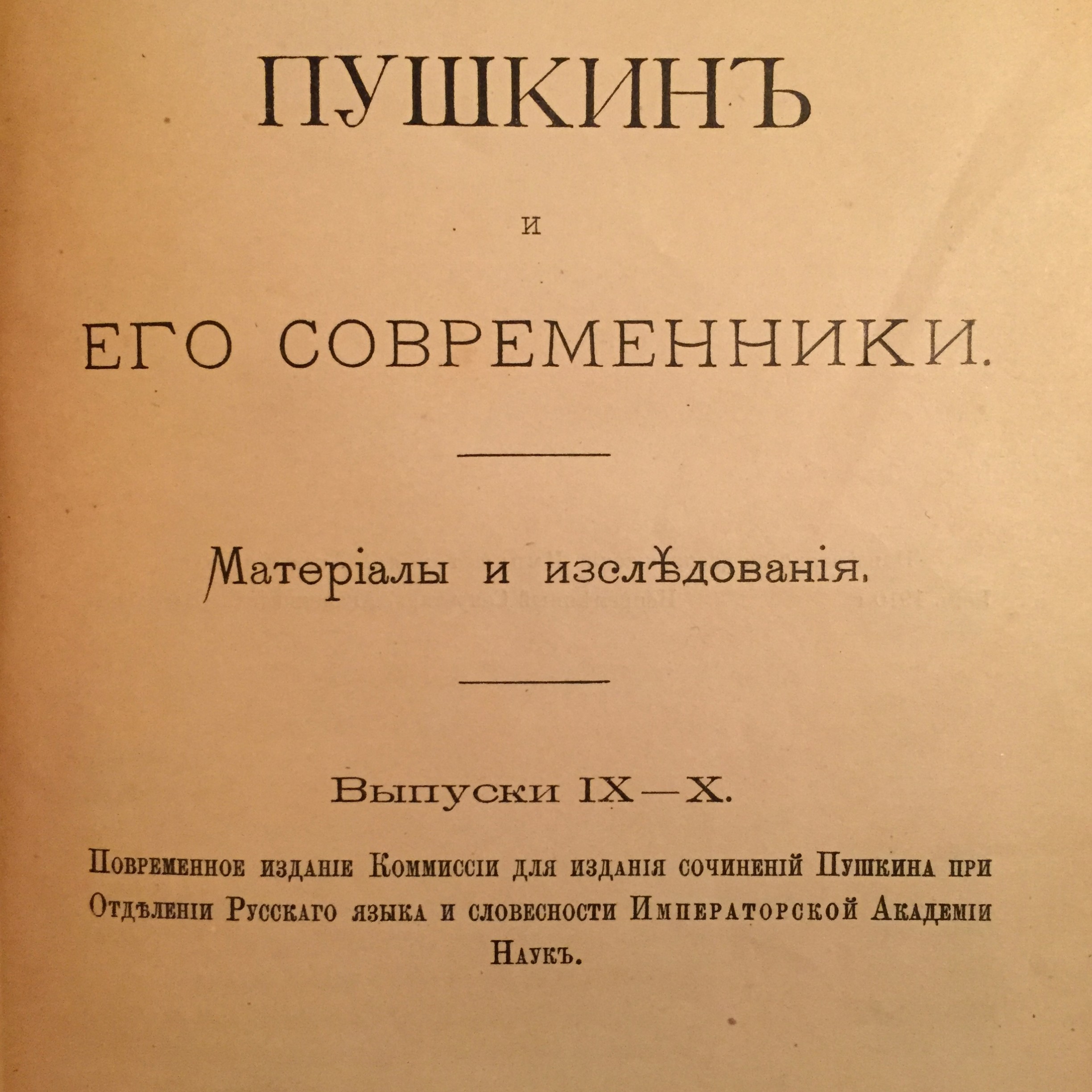
Библиотека А.С.Пушкина. Библиографическое описание.
Пушкин и его современники. Материалы и изследования. Вып. IX- X. Повременное изданiе Коммиссiи для изданiя сочиненiй Пушкина при Отдѣленiи Русскаго языка и словесности Императорской Академiи Наукъ.
СПб.: Тип.Императорской Академiи Наук, 1910. - 461 стр.
-
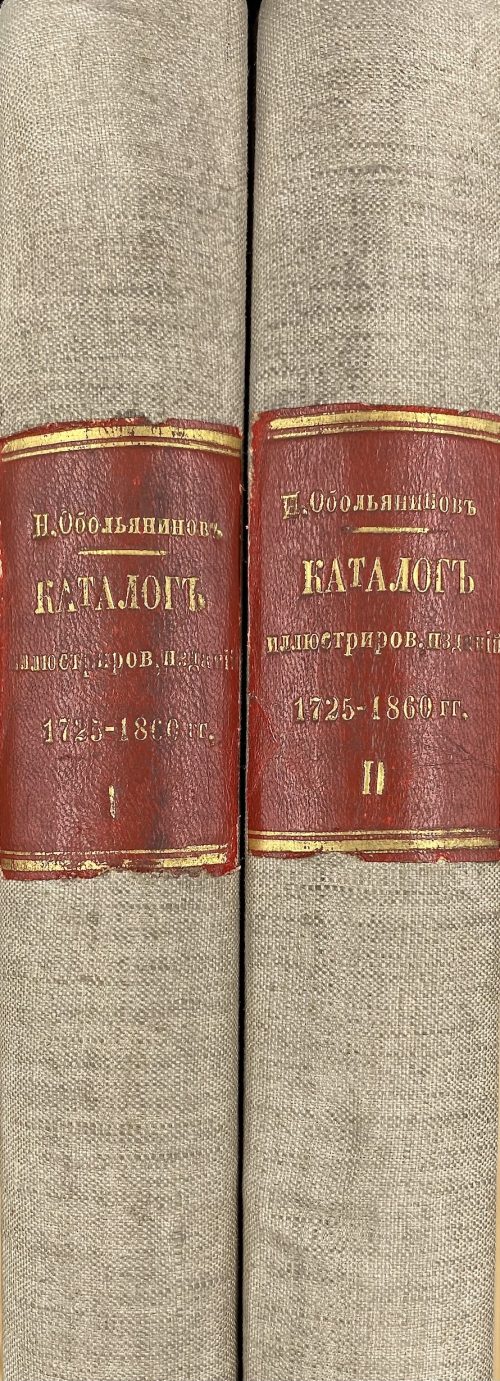 Two volumes, 32 x 24 cm each, uniformly bound in grey cloth with crimson morocco labels with gilt lettering to spine “Н. Обольяниновъ | КАТАЛОГЪ | иллюстриров. изданiй | 1725-1860 гг. | I (II)”, original wrappers preserved. To t.p. verso ink stamps “Latvijas PSR Zinātn̦u akadēmija Fundamentālā bibliotēka”, “1964”, “KATALOGS”, and “Z.A.B. Inv. № 80274”. Printed on laid paper, pagination throughout. 3,038 items with bibliographical descriptions. Title-page: КАТАЛОГЪ | РУССКИХЪ ИЛЛЮСТРИРОВАННЫХЪ | ИЗДАНIЙ | 1725—1860 гг. | — | СОСТАВИЛЪ | Н. Обольяниновъ. | Въ двухъ томахъ | Т. I (II). | ~ | МОСКВА – 1914 (1915). | Товарищество ТИПОГРАФIИ А. И. МАМОНТОВА, | Арбатская пл., Филипповский пер., д. № 11. || Vol. I: Collation: π6 1-424, total 174 leaves; pp.: [i-v] vi-xii, [1] 2-335 [336 errata] (total 348 pages); within green publisher’s wrappers. Vol. II: π2 1-444, total 178 leaves; pp.: [4] [337] 338-686 [687 errata], [688 blank] (total 356 pages); within green publisher’s wrappers. Provenance: Fundamental library of the Latvian Academy of Sciences. Contributors: Николай Александрович Обольянинов (Russian, 1868 – 1916) – author. Анатолий Иванович Ма́монтов (Russian, 1839 – 1905) – publisher.
Two volumes, 32 x 24 cm each, uniformly bound in grey cloth with crimson morocco labels with gilt lettering to spine “Н. Обольяниновъ | КАТАЛОГЪ | иллюстриров. изданiй | 1725-1860 гг. | I (II)”, original wrappers preserved. To t.p. verso ink stamps “Latvijas PSR Zinātn̦u akadēmija Fundamentālā bibliotēka”, “1964”, “KATALOGS”, and “Z.A.B. Inv. № 80274”. Printed on laid paper, pagination throughout. 3,038 items with bibliographical descriptions. Title-page: КАТАЛОГЪ | РУССКИХЪ ИЛЛЮСТРИРОВАННЫХЪ | ИЗДАНIЙ | 1725—1860 гг. | — | СОСТАВИЛЪ | Н. Обольяниновъ. | Въ двухъ томахъ | Т. I (II). | ~ | МОСКВА – 1914 (1915). | Товарищество ТИПОГРАФIИ А. И. МАМОНТОВА, | Арбатская пл., Филипповский пер., д. № 11. || Vol. I: Collation: π6 1-424, total 174 leaves; pp.: [i-v] vi-xii, [1] 2-335 [336 errata] (total 348 pages); within green publisher’s wrappers. Vol. II: π2 1-444, total 178 leaves; pp.: [4] [337] 338-686 [687 errata], [688 blank] (total 356 pages); within green publisher’s wrappers. Provenance: Fundamental library of the Latvian Academy of Sciences. Contributors: Николай Александрович Обольянинов (Russian, 1868 – 1916) – author. Анатолий Иванович Ма́монтов (Russian, 1839 – 1905) – publisher.


